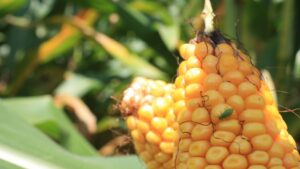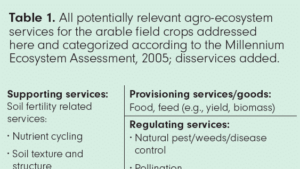Large numbers of egg-laying adult rootworm beetles in a field mean high populations of pest will likely arrive next year.
This past growing season, farmers across Iowa saw a fair amount of variability in influential factors for optimum crop production. A couple of these include the diversity of rain events, with some areas of the state sadly not having enough rain, other areas with more than enough and isolated areas receiving excessive amounts. A second factor includes the variability of pest abundance, like corn rootworm.
For some areas, particularly the dry and droughty parts of Iowa, we saw more corn rootworm beetles and significant plant injury; in other areas, they were hard to find. So, what does this mean for 2018?
As you make management decisions, remember to consider each field on its own. What is the rotation history? Continuous corn production, especially three or more years, favors corn rootworm outbreaks. Using crop rotation can break up the pest life cycle. Is Btresistance a concern in your local area? Those regions with a history of Bt resistance are more likely to see performance issues in future growing seasons.
Were fields assessed for root injury from larval feeding, or were fields scouted with sticky traps to help assess adult activity? Large numbers of adult rootworm beetles can be a signal the egg load is high going into the winter.
What have we learned so far?
Research conducted by the Gassmann Lab at Iowa State University has documented resistance of western corn rootworm in Iowa to Bt-traited corn with the Cry3Bb1 and mCry3a traits since 2009 and 2011, respectively, in continuous cornfields in Iowa. Work with western corn rootworm populations in Iowa has found cross-resistance among the Cry3 traits (Cry3Bb1, mCry3A, eCry3.1Ab). This means rootworm populations resistant to Cry3Bb1 will likely be resistant to mCry3A and eCry3.1Ab.
Recently, there is evidence of field-evolved resistance of western corn rootworm to Cry34/35Ab1 in Iowa. A few years ago, four fields were identified with greater-than-expected root injury to corn hybrids containing the Cry34/35Ab1 trait.
Subsequent laboratory bioassays found this resistance was associated with resistance to Cry34/35 Ab1. However, this resistance was incomplete (survival on Bt corn was less than on non-Bt corn) and thus far appears to be limited in its geographic distribution within Iowa.
In some areas, extended diapause by northern corn rootworms caused root injury to first-year corn. To date, there haven’t been any cases of Bt resistance by northern corn rootworm to any traits. Normal and extended diapause variants of northern corn rootworm do not lay eggs in soybean fields.
Management recommendations
As you develop a corn rootworm strategy for 2018, consider the following tactics:
• Crop rotation remains an effective tactic in Iowa cornfields. Although rotation-resistant northern corn rootworm is present in Iowa, rotation resistance by western corn rootworm is not as common. Rotating to a non-host crop will break the life cycle of western corn rootworm and rotation-susceptible northern corn rootworm. Typically, crop rotation will greatly reduce rootworm abundance in a field during subsequent growing seasons. Consider rotating a field out of corn production at least every five years.
• Use Bt corn hybrids with the Cry34/35Ab1 trait pyramided with a second rootworm Bttrait. However, understand that if western corn rootworm has developed resistance to one of the traits in a pyramid, the utility of a pyramid is reduced.
• Use a non-CRW Bt hybrid with soil-applied insecticides. Layering traits with soil-applied insecticides is not recommended, because it is often not necessary if Bt corn pyramided with Cry34/35Ab1 is planted, and layering traits with insecticide may speed resistance to both strategies.
• Adult rootworm beetle management requires intensive sampling and a well-timed application of foliar insecticides. In general, this is not a cost-effective management option for corn rootworm.
Sticky trap guidelines
Pherocon AM yellow sticky traps set up in the cornfield — from silking through the dent stage — is a good tool to use to assess and monitor for adult corn rootworm beetle populations. For areas in eastern counties with suspected rotation-resistant western corn rootworm, set up sticky traps at soybean flowering and continue through full seed set (mid-July to August).
Action thresholds in corn are two corn rootworms per trap per day. Consider crop rotation if action thresholds are met. If planting corn again the following growing season, use a pyramided Bt trait with Cry34/35Ab1, or a soil-applied insecticide on non-rootworm Bt corn.
Action thresholds in soybeans are 1.5 western corn rootworms per trap per day. If action thresholds are met in soybeans, consider using a pyramided Bt trait or a soil-applied insecticide on non-rootworm Bt corn the following season.
For more information, see the ICM article Guidelines for Using Sticky Traps to Assess Corn Rootworm Activity. What about reducing seed costs and using a corn hybrid without a CRW Bt trait?
Bruce Potter, Extension IPM, and Ken Ostlie, Extension entomologist, from the University of Minnesota, have a good discussion on this topic in Minnesota Crop News. For more information, see Should I reduce the Bt trait acreage in the 2017 corn crop to cut production costs? Here are some highlights:
• Consider the risk from extended diapause northern corn rootworm, as rotated corn may still be affected.
• Other considerations include fields with hybrids maturing late for the area, fields with portions replanted or where crop development was delayed by flooded soils in spring, cornfields with late-season weed populations or adjacent to weedy soybeans, or soybean fields with heavy volunteer corn persisting late in the season. These fields face elevated risk from corn rootworms in 2018.
• For fields that were monitored and were below thresholds in 2017, as well as being excluded from the previous factors, the use of non-Bt traited corn would be a possible option or consideration.
As we prepare for 2018, and successful management of corn rootworm, a long-term strategy is needed that rotates a variety of management approaches over multiple seasons. Use of in-season scouting and monitoring tools, such as sticky traps, helps to assess current field conditions and allows for accurate and timely management strategies to be implemented for the future.
Source: Terry Basol, Wallace Farmer













